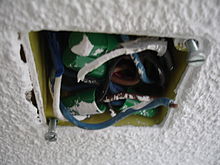Junction box

A junction box (also known as a junction box, device installation box or junction box - referred to as an installation box in accordance with the German standard ) is used in electrical installations to bring together several electrical cables . In Switzerland, a junction box is a subtype of the installation box, which includes junction boxes and inlet sockets .
In Germany it must comply with the DIN VDE 0606-1 standard.
Layout and function
The cables from sockets, lights , switches of the sub-distribution and other permanently installed devices and consumers come together in junction boxes . The switches themselves sit in their own switch boxes . The conductor connections are connected to one another in accordance with the circuit to be implemented ( e.g. push button circuit , cross circuit , switch-off ). Terminal boxes and distribution boxes also have similar functions .
Junction boxes are available in flush-mounted, surface-mounted and cavity wall designs . Surface-mounted junction boxes are often used, for example, in damp room installation, in outdoor facilities or in basement rooms. In living rooms, flush-mounted junction boxes are normally used, which are typically located within the installation zones and often near the ceiling. For the connection of conductors in boxes, either clamps fixed in position or loosely insulated individual clamps as screw clamps or screwless clamps are used.
The following parameters are specified on the inside of the lids of cans bought in hardware stores (2018; there are minor deviations depending on the manufacturer):
- Box 75x75x40: 1.5² (6 terminals, 18 wires), 2.5² (5 terminals, 15 wires)
- Box 85x85x40: 1.5² (6 terminals, 20 wires), 2.5² (5 terminals, 15 wires)
- Socket 100x100x40: 1.5² (6 terminals, 20 wires), 2.5² (5 terminals, 15 wires)
It is noticeable that the information does not correlate with the volume of the doses.
Installation boxes designed for device installation (switches, sockets, etc.) are also available in a deeper design and thus offer additional space for terminals, which can make some additional pure junction boxes unnecessary.
Robust junction boxes are known as terminal boxes and are used in industrial plants, special vehicles, ships, etc., they do not fall into the category of junction and installation boxes.
material
Junction boxes for house installation are now made of flame-retardant thermoplastic . Bakelite or sheet metal lined with tar paper was also used in the past . Surface-mounted junction boxes for use in damp rooms have rubber sleeves to hold the cable sheaths, and sometimes stuffing boxes are also used as in the past. For stressed areas (outdoor use, vehicles and ships), junction boxes are also made of die-cast aluminum. These are optionally equipped with stuffing boxes or with a thread (earlier standard PG, now increasingly metric) for cable glands .
Terminal blocks
The earlier common screw terminal blocks with ceramic support bodies were called terminal blocks. The term was also retained for the thermoset support bodies used later and is sometimes also used for the terminal blocks with plastic support that are common today.
However, the conductors in a junction box are often connected with compression sleeves. These press-fit connections were the only reliable type of connection , particularly with the previously used aluminum lines . Aluminum cables are a major problem when it comes to repairs; although they have grandfathering, they must not be connected to the terminal blocks that are common today. The terminal blocks previously approved for aluminum had lower clamping pressure, but were not reliable. That is why aluminum conductors are no longer used today. There are special compression sleeves for the mixed pressing of aluminum and copper conductors.
Another connection technology are spring- loaded terminal blocks for connecting several individual conductors. They are also only suitable for copper conductors.
Normative framework conditions in Europe and Germany
In Germany, normative specifications must be observed for connections between conductors in the sockets. DIN EN 60998-2-1 (VDE 0613-2-1) applies to loosely insulated individual terminals as screw terminals and DIN EN 60998-2-2 (VDE 0613-2-2) applies to screwless terminals. In accordance with DIN VDE 0606-1, Section 4.1.10 (loosely insulated) individual terminals may only be used in installation boxes for conductor cross-sections from 1.5 mm² to 4 mm². With larger cross-sections, clamps should be selected for the line connections that are fixed in their position in the junction box.
Installation boxes according to DIN VDE 0606-1 connecting material up to 690 V; Installation boxes to accommodate devices and / or connecting terminals (Section 4.4.1.5.) Bear the inscriptions of the maximum parameters to be used inside the box. The conductor cross-section (usually 1.5 mm² and 2.5 mm²) with the maximum permissible number of terminals and conductors is given.
literature
- Alfred Hösl, Roland Ayx, Hans Werner Busch: The electrical installation in accordance with regulations, residential construction, commercial industry. 18th edition, Hüthig Verlag, Heidelberg 2003, ISBN 3-7785-2909-9 .
- Hans-Günter Boy, Uwe Dunkhase: Electrical installation technology The master's examination . 12th edition, Vogel Buchverlag, Oldenburg and Würzburg 2007, ISBN 978-3-8343-3079-6 .
- Winfrid Hauke, Rolf Thaele, Günter Reck: RWE Energie Bau-Handbuch. 14th edition, Energie-Verlag GmbH, Heidelberg 2009, ISBN 978-3-8022-0969-7 .
- Herbert Schmolke: VDE series 45; "Electrical installation in residential buildings", manual for installation practice . 7th edition. VDE Verlag GmbH, Berlin and Offenbach 2010, ISBN 978-3-8007-3029-2 , p. 369 ff .
